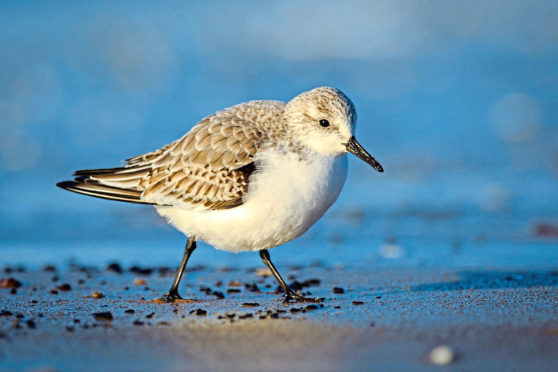By the edge of this sandy beach near Balmedie, north of Aberdeen, the sanderlings dodged the surf on pattering feet, following the flow of the sea as it receded and quickly retreating up the beach again as the rolling water surged back.
Up and down this wild shore skipped these little waders, quickly snapping up tiny crustaceans and worms that had been revealed by the waves. They are such attractive birds with their pearly-pale plumage and continual frenetic activity.
Unusually for a bird, sanderlings lack a hind toe, which is an adaptation that enables them to quickly run on sand. It also means that when it is windy, they are a bit unstable on their feet, suddenly being blown sideways and up into the air before alighting back onto the beach again.
Winter visitors
Sanderlings are winter visitors to Scotland, hailing from breeding grounds in the high Arctic, and their presence on the beach here at Balmedie was a telling reminder of Scotland’s international importance for vulnerable wader populations.
Our relatively benign winters and strategic position on the north-western edge of Europe, combined with sheltered estuaries and Firths rich in invertebrate food, makes Scotland the perfect migratory stop-over and wintering location for many wading birds. Over half a million waders – including knots and dunlins – winter here each year.
I glanced out towards the sea, but the rolling, white-flecked water appeared devoid of ducks such as scoters and eiders. I was not going to give-up that easily, for my top tip when seeking winter offshore seabirds is; if nothing is seen, look again, for you are not searching hard enough.
Red-throated diver
So, I looked again, and quickly spotted a light-greyish bird flying low over the waves, slender-necked and slightly humpbacked in appearance. It was red-throated diver, which swept away on fast-beating wings until it blended seamlessly into the vastness of the sea.
About the size of a small goose, this red-throated diver brought back happy summer memories spent on North Uist where I adored observing these elegant birds on their peaty breeding lochans. Although nesting by freshwater, they would always search for fish in the nearby coastal sea shallows, shuttling back and forth with their catch.
Adults in summer sport the most beautiful plumage, with gentle black lines on the nape of their blue-grey heads, and, of course, that startling red throat. However, the Aberdeenshire bird I had just seen was in its drabber, more washed-out winter plumage.
An old name for the red-throated diver is rain-goose, a reference to the long-held belief its calls are an excellent indicator of forthcoming weather. Short, sharp notes or flying inland are a sign of approaching fine conditions, whereas long, plaintive calls and flying out to sea a portend that rain is on the way. Whether there is any substance to such weather forecasting abilities, I have no idea.
Did you know
Sanderlings which arrive in Scotland to spend the winter have mostly come from Greenland, and possibly even Canada. They are mainly found on sandy beaches, rather than rocky shores.










